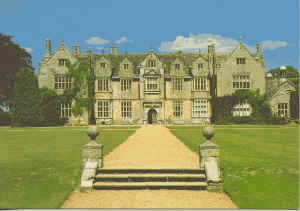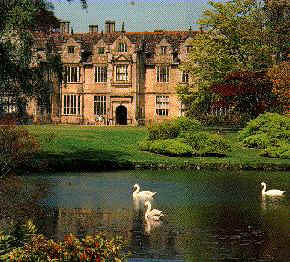Wakehurst Place:
The Culpeper Connection
By Christine Stockwell
 One derivation of the name Culpeper connects it to the
pepperers, merchants who, in
the early Middle Ages, dealt in herbs and other forms of medicinal plants If
this is so, then Nicholas Culpeper. the herbalist and best-remembered of all
his large family, was aptly named. But it is due to the continuous popularity of
one of his many works, The English Physician, first published in 1652 and now
known as Culpeper's Herbal, that his name is naturally associated with herbalism
and plant lore.
One derivation of the name Culpeper connects it to the
pepperers, merchants who, in
the early Middle Ages, dealt in herbs and other forms of medicinal plants If
this is so, then Nicholas Culpeper. the herbalist and best-remembered of all
his large family, was aptly named. But it is due to the continuous popularity of
one of his many works, The English Physician, first published in 1652 and now
known as Culpeper's Herbal, that his name is naturally associated with herbalism
and plant lore.
So it seems appropriate that Wakehurst Place, once the home of a
main branch of the Culpeper family, is now, through an affiliation with the
Royal Botanic Gardens, Kew, an important botanical center containing one of
Kew's most valuable collections, a seed bank which represents more than four and
a half thousand species of plants.
Wakehurst may not have paid tribute to Nicholas Culpeper in his
lifetime, nor extended the hospitality of its household to him, but today its
flourishing gardens make a suitable if unofficial memorial to him.. He seems at
home here, as if some kindred spirit of plantmanship had called him forth, but
though this is a sentimental association, the connection between the Culpeper
family and Wakehurst is a real and historical one.
In 'Wakehurst' two Saxon words are coupled; either 'wic' meaning
a dwelling or ‘wak’, which means moist, and 'hyrst', a wood. It sounds then
as though the Wakehurst family took its name from the place where it originated,
but this could not have been at Ardingly, where Wakehurst Place now stands. It
is known that a Walwerd de Wakehurst bought land at Apuldram, near Chichester,
from the monks at Battle Abbey in the reign of King Stephen, more than fifty
years before any Wakehurst lived at Ardingly. Added to this, the fact that
Wakehurst was not referred to as a location until the beginning of the fifteenth
century seems to confirm that the family gave its name to the place rather than
the reverse.
Early Wakehurst History
It was William Wakehurst who first bought land here in 1205 - an
area not more than forty acres. Fifty years later either he or his son, also
William, owned two hundred and eighteen acres at Ardingly, one hundred and
thirty seven of which the local parson claimed were church property. William
Wakehurst attempted to settle the dispute by offering a rather smaller, five
acre plot, and the parson may have accepted this, but his more persistent
successor re-opened the issue and finally won the rights to the land in court.
In fact he had some difficulty in wresting back those ecclesiastical acres and
was not the only neighbor with whom these first-comers had similar
disagreements.
 Although, for the next hundred and fifty years, most
references to the Wakehurst family are in relation to lawsuits over land claims,
by the end of the fourteenth century it was well established in the Ardingly
community and sufficiently well-respected for John Wakehurst to be made a member
of a commission, set up in 1390, to investigate crimes committed in the
neighboring county of Surrey. It is also recorded that a John Culpeper was
another member of this committee, which shows an early connection between the
two families.
Although, for the next hundred and fifty years, most
references to the Wakehurst family are in relation to lawsuits over land claims,
by the end of the fourteenth century it was well established in the Ardingly
community and sufficiently well-respected for John Wakehurst to be made a member
of a commission, set up in 1390, to investigate crimes committed in the
neighboring county of Surrey. It is also recorded that a John Culpeper was
another member of this committee, which shows an early connection between the
two families.
Richard Wakehurst, John's son, held various official posts in
the county and progressed from being Commissioner in charge of certain land
drainage operations and river-bank repairs to Custodian of the Peace of Sussex.
He was the most eminent of all the Wakehursts and his son, also Richard, stood
to inherit all that had been accumulated in the two and a half centuries since
the family had first settled in Ardingly. However, the younger Richard died
before his father and so it was his two daughters, Margaret and Elizabeth, who
succeeded to the Wakehurst fortunes.
Either because they were too young or because their grandmother,
Elizabeth Wakehurst (the elder Richard's widow), was still alive, the two
heiresses were not immediately entitled to their inheritance and so were put
under the guardianship of their grandmother, two of her near relatives - John
Gaynesford and Thomas Echyngham - and the two executors of their grandfather's
will. Why they were not allowed to remain with their mother, Agnes, is a
mystery. Perhaps she was thought to be too young herself, or inexperienced, to
single-handedly arrange the girls' education and prepare them for their roles as
heads of the family but, whereas it would be understandable if they had been
taken into the main Wakehurst home, to acquaint them with their future
responsibilities, instead they were sent to live with Sir John Culpeper of
Bedgebury at his home near Goudhurst in Kent.
Why this decision was made is not clear, but the fact that Sir
John Culpeper's wife, also named Agnes, is shown on the family tree as the
sister of a John Gainsford, seems significant. Although the surname there does
not have the same spelling as the girls' guardian's, in other references to
Agnes, it does, so suggesting that her brother and the guardian John Gaynesford
were close kinsmen, if not one and the same person. It is not known if the
guardian in question was an uncle or a cousin to the girls and although there is
evidence to show that their uncle could not have been Agnes's brother, no such
evidence is apparent concerning their cousin who was also named John.
What does seem clear is that a great deal of attention was paid
to ensuring the heiresses' safety and that whatever their exact relationship to
Sir John Culpeper, their guardians were confident he would make a worthier
warder than the girl's own mother. He in turn, promised, upon his honor as a
knight, that they would not be wronged while in his charge; an ironic oath when
it was his own two younger brothers who, scarcely a year later, abducted the
girls. Richard and Nicholas Culpeper were said to have descended on Sir John's
and Agnes Culpeper's home at Goudhurst, dressed and armed for war and carried
off the girls who, according to the usual version of the story, wept piteously
and loudly lamented their fate.
Continued on
next page